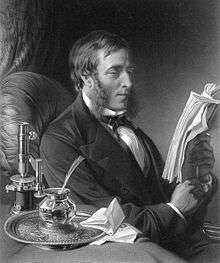Thomas Oldham Barlow
| Thomas Oldham Barlow | |
|---|---|
 Thomas Oldham Barlow (Walter William Ouless, 1882) | |
| Born |
4 August 1824 Oldham |
| Died |
24 December 1889 (aged 65) Kensington |
| Resting place | Brompton cemetery |
| Known for | mezzotint engraving |
Thomas Oldham Barlow RA (4 August 1824 – 24 December 1889) was an English mezzotint engraver. His prints helped to popularise the works of painters like John Phillip and Sir John Everett Millais.
Biography
Barlow was born in Oldham in Lancashire, the son of Henry Barlow, an ironmonger living in the High Street, and Sarah (née) Oldham. He was educated at the Old Grammar School, Oldham, and was then articled to "Stephenson & Royston", a firm of engravers in Manchester. He studied at the Manchester School of Design, where he won a prize of 10 guineas in 1846 for a drawing entitled 'Cullings from Nature'. [1]

He moved to Ebury Street, London, in 1847. His first independent work was a line engraving of John Phillip's 'Courtship', made in 1848, and this led to a close friendship with the painter, the most important of whose pictures he subsequently engraved. These include 'Dona Pepita' (1858); 'The Prison Window' (1860); 'The House of Commons in 1860' (1866); 'Prayer in Spain' (1873); 'Highland Breakfast' (1877); and the celebrated 'La Gloria' (1877). Barlow was the executor of Phillip's will, and drew up a catalogue of the collection of the artist's works which were shown at the Third Annual International Exhibition in London in 1873.[1]
In 1856, Barlow engraved John Everett Millais's 'Huguenot', and in 1860 his 'My First Sermon', and during the latter part of his life was largely engaged upon that artist's works. Portraits of John Bright, Gladstone, Tennyson, Cardinal Newman, Lord Salisbury, and other public characters, painted by Millais for the art dealer "Agnew's", were all engraved by Barlow. Other well-known engravings include the 'Death of Chatterton' (after Henry Wallis); portrait of Sir Isaac Newton (after Godfrey Kneller); portrait of Charles Dickens (after William Powell Frith); and several after Landseer, Maclise, Ansdell, and James Sant.[1]
Barlow engraved Turner's 'Wreck of the Minotaur' for the Earl of Yarborough, who presented the plate to the Artists' General Benevolent Institution, and in 1856, for the same charity, he made a large etching of Turner's 'Vintage of Macon'. Thirty years later he repeated the work in mezzotint, shortly before his death. [1]
In 1858 Barlow founded the "Kensington Life Academy",[2] an informal life-drawing club attended by a small but select group of artists, and which met at the studios of Richard Ansdell (hence the alternative name "Ansdell's"). Barlow was elected an associate engraver of the Royal Academy in 1873, a full associate in 1876, and an academician (RA) in 1881. He was a member and, for many years, secretary of The Etching Club.[1]
Barlow died at his house, Auburn Lodge, in Victoria Road, Kensington, on 24 December 1889, and was buried in Brompton cemetery.[1]
Family
In 1851, he had married Ellen Cocks, daughter of James Cocks of Oldham, who survived him. They had 2 surviving daughters.
Portraits of Barlow were painted by John Phillip in 1856, and by Millais in 1886, and he sat as a model for the figure of the sick ornithologist in the Millais's picture, 'The Ruling Passion'.
References
- 1 2 3 4 5 6 O'Donoghue 1901.
- ↑ Leighton and the ‘Kensington Life Academy’ ("Lord Leighton's drawings).
- Attribution
 O'Donoghue, Freeman Marius (1901). "Barlow, Thomas Oldham". In Sidney Lee. Dictionary of National Biography, 1901 supplement. London: Smith, Elder & Co. pp. 127–8.
O'Donoghue, Freeman Marius (1901). "Barlow, Thomas Oldham". In Sidney Lee. Dictionary of National Biography, 1901 supplement. London: Smith, Elder & Co. pp. 127–8. - Susanna Avery-Quash. "Barlow, Thomas Oldham" Oxford Dictionary of National Biography, Oxford University Press, 2004 accessed 5 January 2008.
External links
| Wikimedia Commons has media related to Engravings by Thomas Oldham Barlow. |
- Thomas Oldham Barlow website
- Works by Barlow (National Portrait Gallery, London)
- Works by Barlow (Government Art Collection)